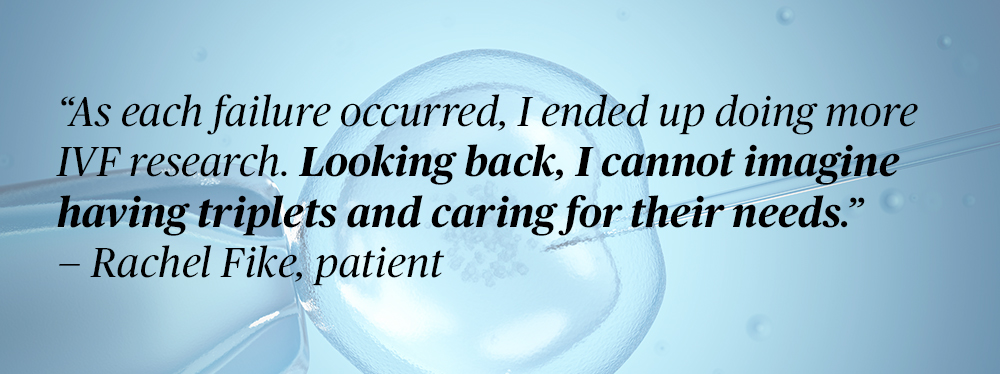After Rachel Fike’s first two rounds of in vitro fertilization failed, her doctor declared it to be a case of poor-quality eggs. More than 176,000 IVF cycles are performed in the United States each year, but it can be an exhausting process. The woman is injected with medication that triggers egg growth, then the eggs are removed with a hollow needle and combined with sperm in a lab. The resulting fertilized eggs (embryos) are transferred into the uterus. Each round takes about six weeks. After those two failed rounds, Fike and her husband decided not to try again, but they changed their minds a year later. Back at the same fertility clinic, Fike endured two more failed IVF cycles. Each time, Fike asked that the embryos be tested before transfer to screen out any with chromosomal abnormalities. The clinic refused.
“I was told ‘no’ over and over again. Our doctor was very dismissive of the procedure in general,” Fike says. Typically, about 20 to 60 percent of eggs are chromosomally abnormal; the percentage increases as a woman ages. Chromosomal abnormality is one of the most common causes of all miscarriages. Researchers have found that earlier forms of embryo screening have no impact on success rates, but Fike was convinced the new type of test, which can look at all 24 chromosome pairs, would help her chances.
Did Fike have a right to request this specific procedure? If her doctor believed embryo screening was unethical due to its ineffectiveness or because it can be used to select gender, did he have a responsibility to refuse to perform the procedure?

Patient autonomy is an important issue in every area of medicine. But autonomy doesn’t mean doctors should do whatever the patient wants; it means doctors should allow patients to make treatment decisions after considering the risks, benefits, and doctor’s recommendations. The problem is that in the field of assisted reproduction, it’s not just that a patient’s wishes may go against a doctor’s better judgment—it’s that fertility specialists can’t even agree on best practices amongst themselves.
Opinions vary widely over the optimal number of embryos to transfer—many insist singleton babies are the only acceptable outcome, while others feel twins are just fine too. Nor is there general consensus around when to deny treatment to women above a certain age, of a certain body weight, or because of lifestyle factors such as smoking or drinking. The American Society for Reproductive Medicine recently increased the maximum suggested age for IVF from 52 to 55, because success with donor eggs in women in their 50s and early 60s “suggests that pregnancy may be possible in virtually any woman with a normal uterus.” Yet in Quebec, a bill is under consideration that would ban the treatment of women over 42. When using their own eggs, the IVF birth rate for women ages 43 to 44 is 5 percent; after age 44, that rate drops to one percent.
Beyond the decisions made for each cycle, there’s also the issue of how many failed cycles a patient should endure. There is no recommended maximum number of IVF cycles, but pregnancy rates diminish after four to six cycles, which is why insurance companies and governments cap the number of attempts they will cover. For 42 percent of the IVF cycles performed in 2012, the women reported undergoing one or more previous cycles, according to the Centers for Disease Control and Prevention.
“The central issue is where to draw the line in respect to the doctor’s and patient’s rights and responsibilities,” Bart Fauser and Paul Devroey wrote in the 2011 academic book Baby-Making: What the New Reproductive Treatments Mean for Families and Society. “Any doctor working in reproductive medicine will do what’s best for the patient. What that best is, however, remains a grey area.”

Last month, the tragic death of an Arizona mother after complications from giving birth to IVF-conceived quadruplets renewed the debate over the ethical number of embryos to transfer. In the U.S., the majority of IVF pregnancies are singleton babies—approximately 30 percent result in twins and three to four percent result in triplets or greater. Complications can arise in any pregnancy; multiples always involve greater risk. Some studies show that all babies conceived with IVF are at a greater risk of complications, such as premature birth and low birth weight, than spontaneously conceived babies.
According to ASRM guidelines, singletons are the goal of IVF, but the acceptable number of embryos to transfer can range from one to five based on careful consideration of each patient’s unique circumstances: age, previous treatment failures, infertility diagnosis, use of donor eggs, and the number of days the embryos survived in the lab, among others.
In a 2008 survey, however, 52 percent of U.S. fertility doctors said they would deviate from ASRM guidelines by patient request.
“The truth is that 30 percent of infertile couples want twins; [they] want a finished family in one go because they might only get one chance to be pregnant,” explains Vitaly Kushnir, a reproductive endocrinologist at the Center for Human Reproduction in New York. He says the international push toward single-embryo transfers is misguided, and that strict limitations infringe on patient autonomy and don’t allow treatment plans to be individualized. Another commonly cited argument for multiple embryo transfers is that transferring one embryo can lead to lower birth rates. According to 2012 data from the CDC, 31 percent of single-embryo transfers resulted in a birth, but put in two embryos and the birth rate jumps to 43 percent. The rub is that with greater chance at success comes greater chance of multiples, and with multiples come greater risks.

In her first round of IVF, Fike’s doctor transferred three embryos. For the second round, two embryos were transferred, the third, three again, and the fourth, two embryos. “When we first started the infertility process, I didn’t know enough to ask certain questions or even question if what the clinic was doing was the right thing for my family in regard to carrying multiples,” Fike says. “As each failure occurred, I ended up doing more IVF research. Looking back, I cannot imagine having triplets and caring for their needs.”

In the U.S., the government exerts very little control over fertility treatment. The ASRM pens practice guidelines and opinion statements to address diagnostic, ethical, and therapeutic dilemmas, but clinics are not legally required to follow these guidelines. The only law concerning IVF is that fertility clinics report the basic details of each treatment cycle—such as outcomes, infertility diagnosis, number of embryos transferred, use of fresh or frozen embryos, donor or non-donor eggs—to the CDC every year. The CDC then publicly publishes these data as “success rate reports.” Despite being a legal requirement, there are no consequences if a clinic doesn’t report to the CDC: It is simply listed as “non-reporting.”
Even this seemingly lenient regulation can impact care. Kushnir says the way data are reported and published by the CDC influences clinics’ behavior, leading to conflicts of interest. Some doctors may be more interested in posting high success rates than in doing what the patient wants or adhering to ASRM guidelines. Clinics need good success rates to attract patients; to create those positive success rates, they need to treat good-prognosis patients. In the case of poor-prognosis patients, doctors may create conditions that are more likely to lead to success: They may be more likely to encourage use of donor eggs or the transfer of a higher number of embryos, but these may not be what the patient really wants.
And without reliable data, the line between good and poor prognosis can be difficult to define. “I often tell my patients that my biggest frustration is that I only deal in probability, rather than in true prediction. I wish there were a crystal ball that would let me predict the future,” Frances Ginsburg, director of reproductive endocrinology at Stamford Hospital in Connecticut, laments in an infertility association fact sheet. “In the meantime, I continue to try to distinguish between a ‘sure thing’ and a long shot. I wish there were a better way.”

Complicating what it means to do good for a patient are the paradigms of private versus government-subsidized medicine. In Baby-Making, Fauser and Devroey write that “the former pays undue respect to the autonomy of the paying patient, while the latter has to accept the limitation of scarce resources and the need to withhold treatment if it seems futile or merely non-cost effective.”
Most insurance doesn’t cover the cost of IVF in the U.S., so the majority of patients pay their own way—an average $12,400 bill for one cycle. (Only 26 percent of companies with 500 or more employees offer insurance coverage for IVF.) To ease costs, many fertility clinics offer success-or-refund programs where couples pay a flat fee (typically twice as much as one IVF cycle) and receive up to six cycles. If they don’t have a baby, they get their money back. If they have a baby after one cycle, they’ve essentially just paid double. Kushnir feels “there are major ethical issues” with these programs because they are often only made available to patients who are highly likely to become pregnant in the first few cycles. Other clinics offer discounts to patients who opt for single-embryo transfers. By incentivizing certain treatment options, these programs may influence patient decisions based on financial reasons rather than medical science.
Lack of insurance coverage reflects—and perpetuates—the pervasive American view of assisted reproduction as a lifestyle choice, not the treatment of an illness. “There is often a lack of sensitivity toward people with fertility problems. With nearly 7.5 million Americans suffering from infertility, this is a sad attitude toward a very painful problem,” writer Amy Klein tells me. In her time chronicling her fertility treatment journey as a journalist, she’s collected her share of inconsiderate responses. “People—especially women—can have very strident reactions to the whole topic of fertility. In America, many believe having your own genetic children can be selfish. Comments such as ‘Why don’t you adopt?’ completely ignore how difficult and complex adoption is for both parents and children. ‘You should have had children when you were younger’ ignores the fact that so many younger women also have fertility problems.”

In countries where IVF is covered under government-provided health care, the treatment isn’t viewed as an elective procedure. But, because the government pays, it can set strict limitations. This might mean that IVF isn’t just for the wealthy or well insured, but it also means that, ultimately, medical decisions must be made within the government’s parameters. People may be more willing to accept such restrictions when care is free. On the other hand, if only a certain number of cycles are covered, and doctors push patients toward single-embryo transfers each time, it may be frustrating. “In Europe, infertility is more heavily regulated than any other field of medicine,” Fauser and Devroey write. “These interventions conspire against the rights of a couple to have a child—or at least to raise conflict between their legal rights and their human rights.”
Kushnir explains that more regulation doesn’t necessarily translate into better care. “When the government intervenes, it often has unintended consequences. In the United Kingdom, they don’t allow compensation of sperm or egg donors, so they have long, long waiting lists for couples who need donors. You could get into the ethics of compensating donors, but the reality is that people come here [to the U.S.] from the U.K. for donor sperm and eggs.”
After failed IVF attempts in the U.S., Klein went to Israel, where IVF is free for citizens like her. The government subsidizes treatment for your first two children. (Private treatment only costs $6,000.) Klein, who is currently working on her memoir, No Sleep Til Baby, says it was “so nice to be in a place where no one questions your desire to have kids.” In an upcoming series for the Israeli news site Haaretz, she examines why women choose to cross borders for fertility care. A 2009 study estimated that, in six European countries, 20,000 cross-border fertility treatments happen each year. Patients travel abroad for care in search of more affordable treatment, higher success rates, donor eggs or sperm, or a less-stressful treatment environment.
For some patients, being turned down by a doctor or restricted by regulations isn’t a stopping point; it’s just another hurdle to overcome. When it comes to having a child, many people will exhaust any and all avenues—financial or geographic—to find a way around “no.”

Repeated fertility treatment can be physically, emotionally, and financially draining. After being disappointed four times, the Fikes decided to visit a different clinic and give IVF a fifth and final try. This time, the clinic tested her embryos and found that, out of nine, four were chromosomally normal. “Our second doctor thought I met the criteria for testing because I was over 35, I work with radiation for a living, and I had previous miscarriages,” Fike tells me. “The doctor tries to convince most of his patients to do testing. He has seen a huge increase in pregnancies and multiples with the additional test.”
Two embryos were transferred into her uterus. “By the time we went to the second clinic we had no hope that we would be pregnant. This would be our last transfer,” Fike says. For their first four cycles, the Fikes’ insurance covered half the procedure costs and 30 percent of the IVF medication costs. For this fifth cycle, the couple paid full price because the doctor was out-of-network. They took out a $20,000 loan, which they paid off by selling their house. To save money, they bought the IVF medications overseas. This time, Fike finally got pregnant—with twins.
If the doctor had performed embryo screening at the first clinic, would the Fikes have experienced so many failed cycles? Should it always be a patient’s prerogative to seek a second opinion, to find a doctor who will perform specific procedures, implant more embryos, or allow repeated treatments? When should patients accept that “no” really is the answer?
Restrictions and guidelines aim to improve care by promoting transparency and drawing solid lines through the grey areas, but these can have unexpected consequences on how care is given and received. Care can’t be entirely unregulated, but doctors should be free to make treatment recommendations based on the best interests of the patient without worrying about success rates or being limited by arbitrary rules. Kushnir adamantly believes well-informed patients should be the ones making treatment decisions. “No one prescription fits all patients. We need to work to make fertility treatment more accessible for everyone.”
Lead photo: A display of successful patients in an embryologist’s office. (Philip Milne/Flickr). Pull quote photo: (Sebastian Kaulitzki/Shutterstock).





